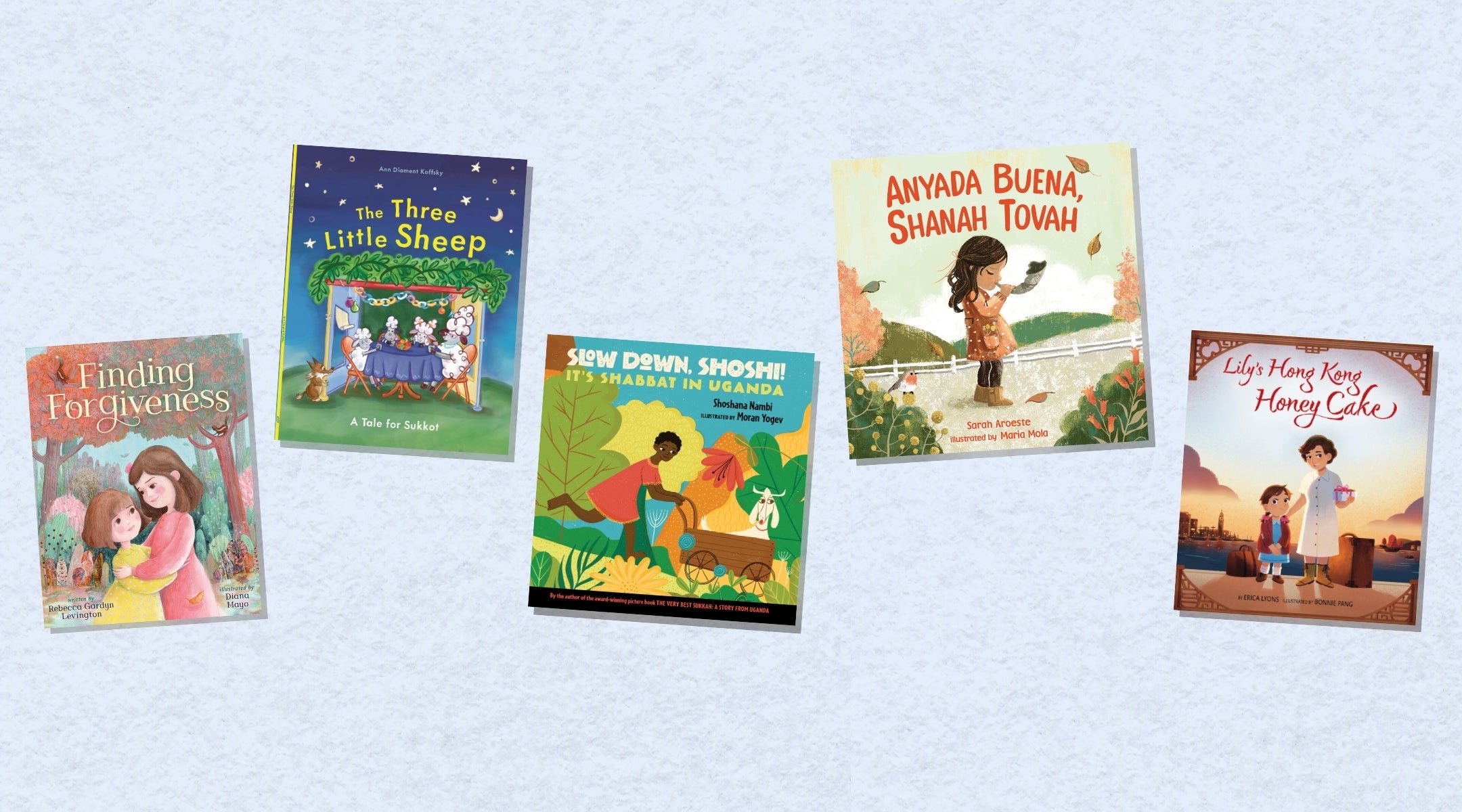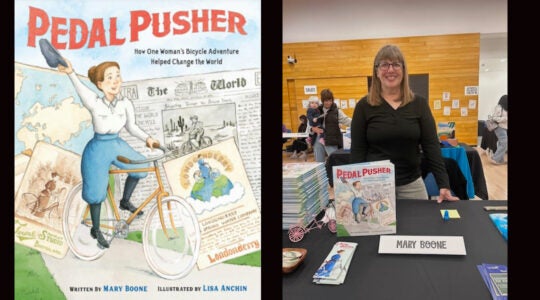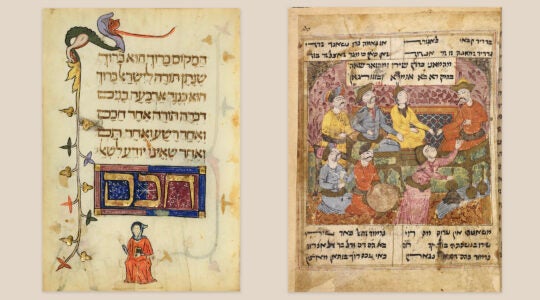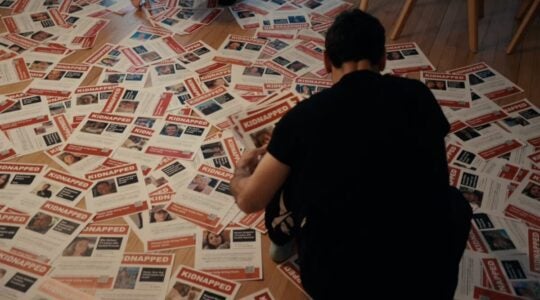A laugh-out-loud Sukkot story that reimagines the classic tale of the three little pigs; an inspiring work of historical fiction story about a Jewish family in Vienna fleeing Nazi persecution and becoming refugees in Shanghai; and a heartwarming Rosh Hashanah story about two quarreling sisters who promise to be better as the Jewish new year begins.
These are among the titles in the new crop of kids books for the High Holidays that echo the themes of the holidays — a time for celebration and reflection, starting anew and welcoming guests.
Here’s a look at some of the notable reads for kids of all ages.
“My Shofar: A Rosh Hashanah Board Book”
Ann Diament Koffsky
Apples & Honey Press; ages baby-age 2
In this lively story, a playful young elephant with a pink bow tries hard to blow a very loud blast from her shofar, the kid-size version of the ram’s horn blown at synagogues during Rosh Hashanah. Kids will giggle when they discover what’s blocking the sound. Finally, the young elephant can blow a loud tekiah.
“Anyada Buena, Shanah Tovah”
Sarah Aroeste; illustrations by Maria Mola
Kar-Ben publishing; ages 2-5
As fall begins, a young Sephardic girl and her family welcome Rosh Hashanah, the Jewish new year. “Anyada buena, shanah tovah,” she says, using the Ladino holiday greeting. Sarah Aroeste’s rhyming story — animated with Maria Mola’s colorful illustrations — is sprinkled with Ladino words, the centuries-old Sephardic language that Aroeste is one of the leading voices bringing to life today. She helps her father bake a golden brown round challah, among the special foods that grace her family’s Sephardic Rosh Hashanah table.
“Kayla and Kugel’s Super Sweet Rosh Hashanah”
Ann Diament Koffsky
Apples & Honey Press; ages 2-5
In the sixth book in a series about a Jewish girl and her canine sidekick, Kayla and Kugel are tasked with getting supplies for Rosh Hashanah. But hijinks ensue when Kugel jumps into the pond where Kayla and her family will carry out the tashlich ritual and otherwise causes mayhem. In the end, the book demonstrates how Rosh Hashanah offers an opportunity for self-improvement.
“Lily’s Hong Kong Honey Cake”
Erica Lyons; illustrated by Bonnie Pang
Apples & Honey Press; ages 4-8
In Erica Lyons’ inspiring story of historical fiction, kids follow Lily, as her family flees Nazi rule in Vienna, where they own a bakery popular for their Rosh Hashanah honey cake. As Nazi-rule refugees in Shanghai, they open a bakery where they bake honey cake to welcome in a sweet new year. When they are forced to flee again, they must remain temporarily on the ship in the Hong Kong port along with other Jewish refugees. When Rosh Hashanah arrives, the clever Lily and the ship’s chef improvise with what they have and surprise everyone with loaves of the sweet honey cake. Lyons’ narrative is brought to life in Pang’s illustrations that reflect all of the places Lily learns to call home. Back pages include the history of Jews in Shanghai.
“The Three Little Sheep: A Tale for Sukkot”
Ann Diament Koffsky
Green Bean Books; ages 3-8
Jakey, Joey and Jennie are three adorable little sheep who help build their family’s sukkah in this humorous version of the Three Little Pigs. During the seven-day harvest holiday, Jewish families eat their meals in a sukkah — a small, open-roof hut — as a reminder of the dwellings of the ancient Israelites’ desert journey after God freed them from slavery. When the sheep grow too big to fit in their sukkah, mama sheep sends them off to build their own. The two older brothers build sukkahs that the (not-too-scary) wolf blows down. But the youngest sister builds a sturdy one, with room for her brothers. When the wolf shows up, he can’t huff and puff and blow it down. Jennie realizes he’s lonely and invites him to join them, reflecting Sukkot’s theme of welcoming guests.
“Slow Down, Shoshi!: It’s Shabbat in Uganda”
Shoshana Nambi; illustrated by Moran Yogev
Kalaniot Books; ages 5-7
In Rabbi Shoshana Nambi’s heartwarming story, Shoshi, whose family is part of the Jewish Ugandan community — the Abayudaya — is a girl-on-the-go, always excited and in a hurry. She loves to help her grandfather, her Jjajja, harvest her family’s special coffee beans and bring them to the market. On Fridays, Shoshi buys food for her family’s Shabbat. “Slow down, Shoshi,” her grandmother cautions before she heads off along with her playful goat. But in her haste at the market, Shoshi forgets the Shabbat candles. With the help of her wise grandmother, Shoshi comes to understand the true meaning of welcoming Shabbat and the joy of being part of the Abayudayah community. Moran Yogev’s collage-style illustrations capture village life and the beautiful East African landscape.
“A Sukkah for Bella”
Jodie Sadowsky; photographs by Frannie Wilson
Lovevery publishing; ages 3-8
In Jodie Sadowsky’s story, brought to life in Frannie Wilson’s photographs, kids meet Bella, an endearing girl who loves to build things. This year, Bella — the youngest in her family — is eager to help build her family’s sukkah. Kids will relate when Bella gets frustrated when she can’t do everything the older kids do. But Bella brings her flair to the sukkah by decorating it with colorful, handmade paper chains. At the story’s end, a beaming Bella holds a lulav and etrog, the fronds and fruit that are part of the holiday ritual. This book comes from a popular educational toy company that has expanded into publishing and frequently illustrates its literacy materials with photographs rather than illustrations.
“Finding Forgiveness”
Rebecca Gardyn Levington; illustrated by Diana Mayo
Farrar, Straus & Giroux; ages 4-8
In Rebecca Gardyn Levington’s touching — and relatable — story channeling the High Holidays spirit, two sisters have an argument on the day before Rosh Hashanah that leaves them both sulking. The next day, at their synagogue, when Jews reflect on the past year and pray for forgiveness, the older sister notices her sister looking sad. She should have been a better listener, she realizes. When her family gathers at the river with the congregation for tashlich – the ritual tossing away of sins — the older one sees her sister still looking sad. She apologizes and the sisters make up with a hug and promise to be better. The book includes suggestions for meaningful apologies that all children can use.
Correction: This piece has been revised since publication to correct a mischaracterization related to “A Sukkah for Bella.”
JTA has documented Jewish history in real-time for over a century. Keep our journalism strong by joining us in supporting independent, award-winning reporting.






